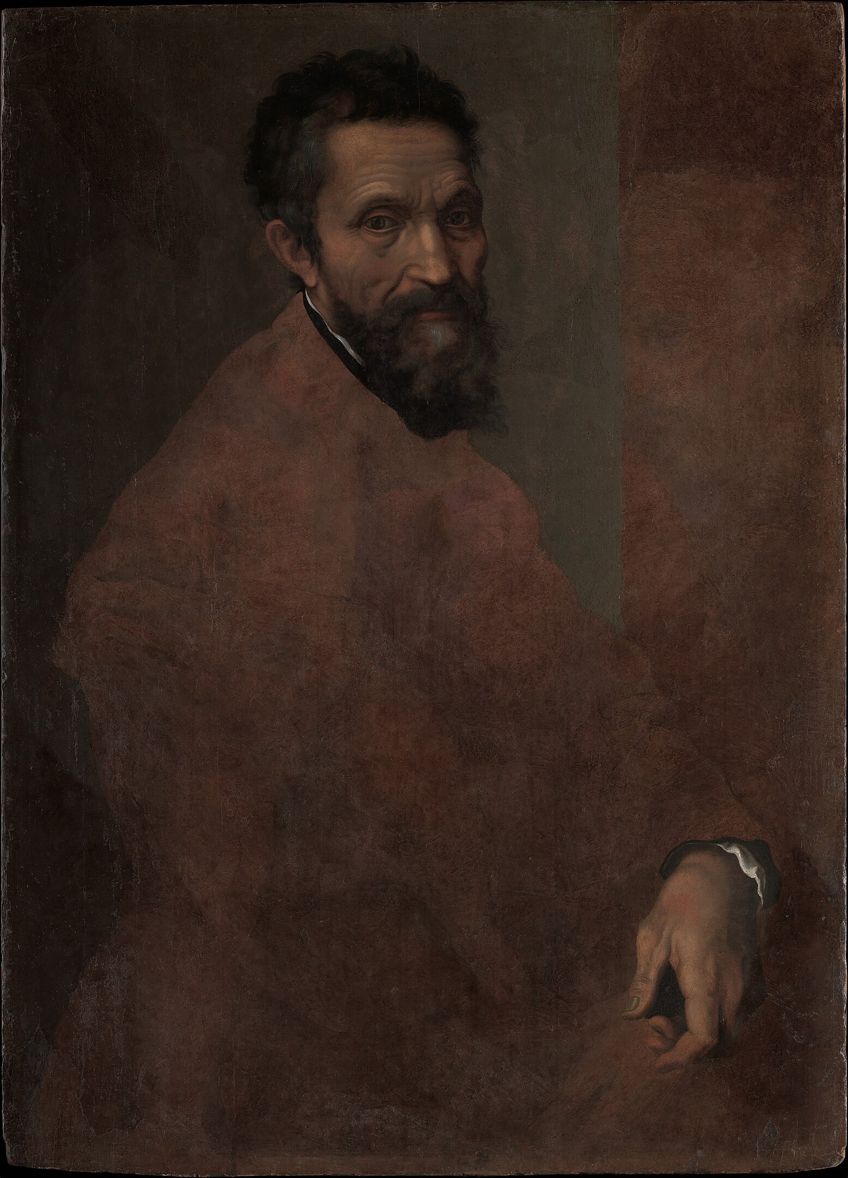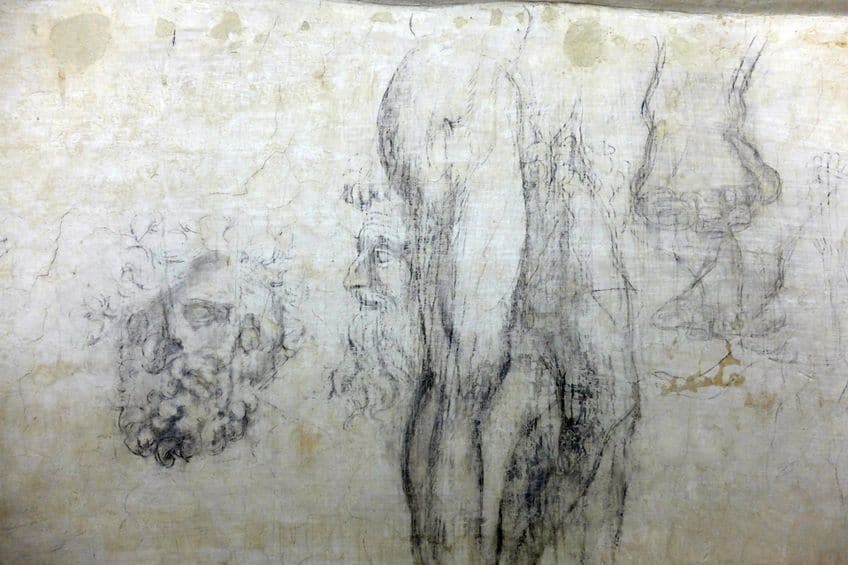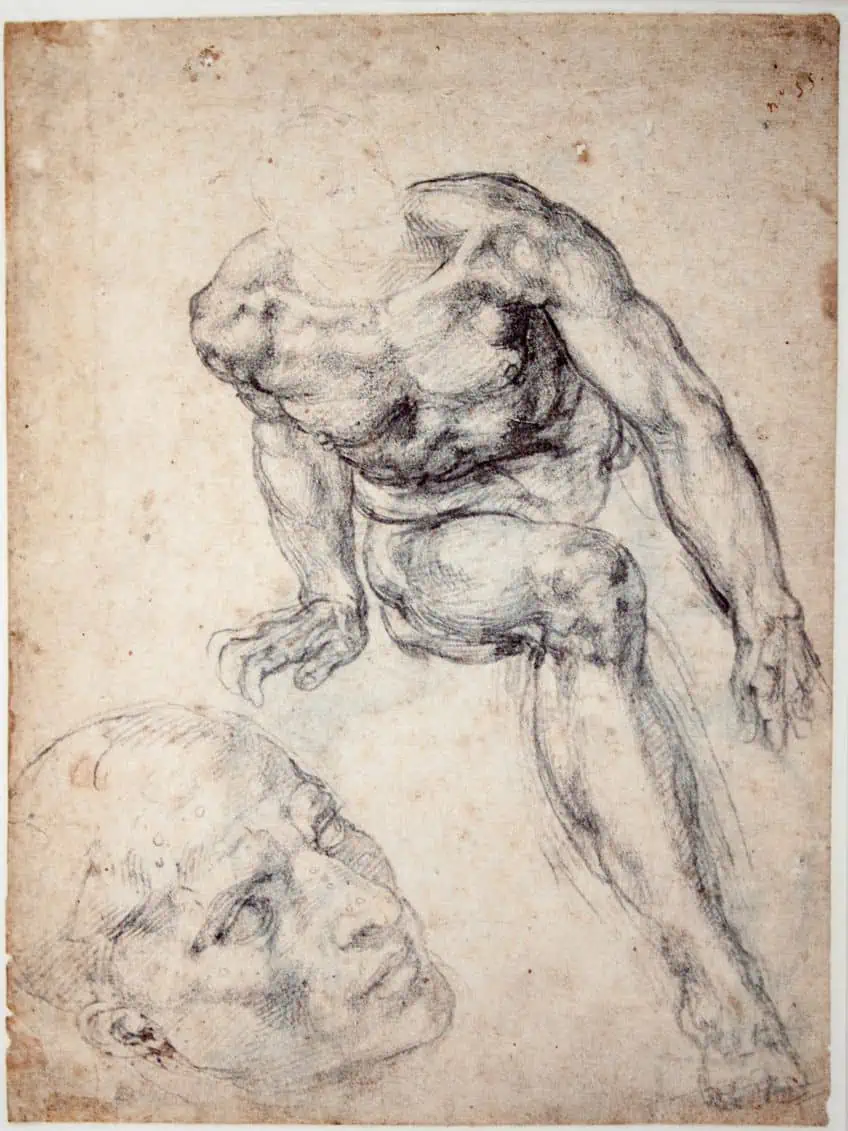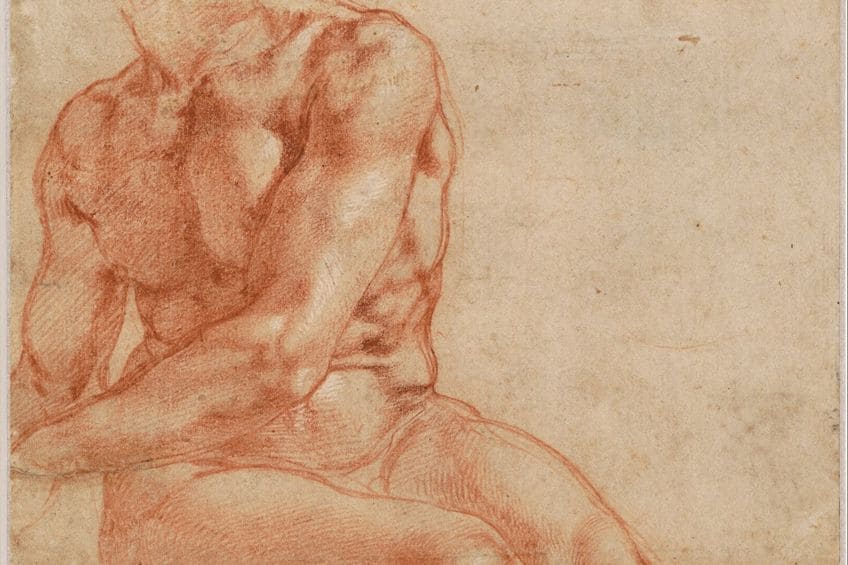Michelangelo Drawings – Explore the Many Talents of This Artist
Michelangelo was one of the most talented artists of the High Renaissance, who was best known for his hard work and dedication to creating some of the most unique and technically excellent sculptures. His contribution to the Vatican City with the ceiling frescoes of the Sistine Chapel was by far one of Michelangelo’s largest projects, but, what about his drawings? In this article, we will explore the significance of the master draftsman’s drawings, as well as his style, technique, and a few of the unique qualities in some of his most famous drawings. Keep reading for more about the intriguing nature of Michelangelo’s pencil sketches!
Contents
Master Draftsman: Michelangelo Buonarroti
Michelangelo Buonarroti was by far the most famous and well-respected icon of the Italian High Renaissance who pioneered many unique and unconventional approaches to sculpture, painting, and even drawing. Michelangelo was a perfectionist who would often work long hours without food or water to complete and perfect his projects. Michelangelo was also known to be an excellent architect who also designed and helped construct the dome of St. Peter’s Basilica. Michelangelo embraced drawing before he could explore painting and used drawing to express the inner workings of his imagination through creative sketches with complex compositions featuring symbols of the Renaissance that were connected to his keen observation of the world and his role as an artist. The Italian master’s drawings are considered especially important in his artistic career since his preparatory sketches in pen, ink, and chalk were the mastermind assets behind the mind of some of his greatest paintings.

The Significance of Michelangelo’s Drawings
Why are Michelangelo’s drawings so important in the art world? While not many of his drawings remain since he burned most of them, Michelangelo’s sketches are considered unique works in their own right and are the only surviving works that give one insight into the master artist’s creative process. His technical skill in many of his figurative works also showcases Michelangelo’s willingness to perfect the human form. The artist often studied cadavers and performed dissections to gain a better understanding of the musculature of the human body, such that he could perfect his drawings.
Michelangelo’s sketches were highly detailed and not just random doodles of what he thought would be ideal for representing the perfect human form. In achieving images of ideal quality, Michelangelo deepened his artistic practice, which was associated with his spiritualist beliefs and a sort of realization of the divine and the act of creation itself.
Michelangelo’s sketches offer many valuable insights into his artistic process and techniques, which allow viewers to witness the development of his ideas and his thought process around composition and design. Michelangelo’s drawings demonstrate his meticulous attention to detail and planning, especially when it came to the construction of monumental structures or works. His drawings showcase his mastery of human anatomy as well as his ability to capture emotional expressions with precision and a sense of Realism.

Michelangelo was highly skilled and learned how to hone his skills in light and shadow through drawing. He also used drawing to practice different poses of the human form, many of which can be seen in his sculptures and paintings. Michelangelo’s ongoing dedication to perfecting anatomical studies demonstrated his knowledge of the physicality of human muscles, proportions, and bones, which truly added a lifelike factor to his work. The draftsman’s mastery over techniques like chiaroscuro also showcases his understanding of contrast and the way it can be created through drawing techniques such as cross-hatching, fine contour lines, and controlled intricate line work.
Types of Drawings Created by Michelangelo
Michelangelo explored different subjects and elements in his detailed sketches and drawings, which included anatomical studies of the human body, musculature, poses, and movements, as well as architectural plans and draft proposals for many unrealized architectural projects. His sculptural studies are also rich sources of information on the planning of his works. The prolific draftsman also created figure studies, which formed the fundamental aspect of his artistic process. Michelangelo created numerous figurative studies that explored the ideal human proportions, as well as the structure of the body, which enabled Michelangelo to render his figures with a high degree of Realism and accuracy.
His preliminary sketches depicted his experimental side, which often portrayed basic outlines and figurative gestures and was perhaps Michelangelo’s first visualization of his ideas into definitive concepts.
Additionally, his detailed studies also showcased a refinement of details on specific features, such as hands, facial expressions, and textures like drapery. These types of studies illustrate Michelangelo’s meticulous observational skills, which rival even the drawings of Leonardo da Vinci. Michelangelo also had a more lighthearted side to his creative process and produced a few caricatures that were exaggerated and humorous projects that showcase the master draftsman’s playful side. Finally, his versatility as a draftsman was best captured in his technical architectural drawings, which showed off his understanding of proportion, space, and structural elements across a multitude of projects.

Unique Studies by Michelangelo
Michelangelo was not only a versatile artist, but also a highly talented and complex thinker whose active imagination spilled over into many of his drawings, resulting in unique works of art.
Below, we will analyze a few interesting sketches by Michelangelo that show off some of the most unique qualities of Buonarroti’s hand.
Seated Male Nude; Separate Study of a Right Arm (1511)
| Date | 1511 |
| Medium | Red and white chalk on paper |
| Dimensions (cm) | 27.9 x 21.4 |
| Where It Is Housed | Teylers Museum, Haarlem, Netherlands |
This stunning detailed nude figure drawing is a remarkable demonstration of Michelangelo’s depiction of the athletic male nude, also called an ignudo. Here, Michelangelo used strong outlines and red chalk to accentuate the flesh and contortions of the muscles on the back, shoulders, and leg of the figure, which appear to almost jump off the page. Michelangelo also used white chalk to highlight the lighter areas of the flesh, which give one an indication of the figure’s skin color and highlights the softer zones of the body.

One can also see the cross-hatching technique used in the separate study of the right arm that Michelangelo used to narrow in on the contours of the muscle by using compacted and harsher lines for the depressions on the skin. Michelangelo made sure to use every space he could find on a piece of paper and created many double-sided studies of works that were probably practice sketches for him.
He was so dedicated to understanding anatomy and maximizing his knowledge that he even drew the parts of the body that would not have been seen in an artwork.
Study of Male Nude from Behind (c. 1512)
| Date | c. 1512 |
| Medium | Red chalk on paper |
| Dimensions (cm) | 15.7 x 19.3 |
| Where It Is Housed | Private collection |
This 16th-century drawing by Michelangelo was a unique find for art historians after debuting in the hands of an anonymous collector in 2014. The drawing was a study from one of the artist’s most famous paintings, the Worship of the Brazen Serpent, which was featured in the Sistine Chapel ceiling in 1508. What makes the drawing so special is that it is among the few and rare surviving preparatory drawings for one of Michelangelo’s greatest masterpieces. Before Michelangelo died, he burned hordes of his drawings, sketches, and cartoons and luckily for historians, this drawing was among Michelangelo’s selected sketches that were worthy of keeping. The drawing showcases the muscular back and shoulders of a figure executed in red chalk.

At first, the drawing was presumed to be viewed horizontally, however, the drawing was analyzed and determined to be viewed at 90 degrees clockwise. An interesting find in the analysis of the drawing revealed that a few collectors from the 19th century had previously left their inscriptions and initials on it with one of the figures resembling the initials of Sir John Charles Robinson, who was among the top collectors of Michelangelo’s work. According to an analysis by surgeon Francis Wells, the drawing was not entirely accurate in its skeletal and muscular design, however, Giorgio Vasari’s opinion of Michelangelo’s work notes his awareness of human anatomy and his tendency to prefer expression over strict anatomical fidelity.
So, why did Michelangelo destroy his drawings? Michelangelo destroyed many of his drawings and sketches by the fire with many speculations about why he did it.
One of the main theories suggests that Michelangelo wished to protect his artistic reputation in keeping with his perfectionist habits. Michelangelo did not wish to publish his many attempts at perfecting his masterpieces for fear that his adversaries and contemporaries might question his genius. Michelangelo may have also wanted to preserve the knowledge and insight into his creative process in a preemptive act of destruction to guard his artistic legacy. Michelangelo’s figure drawings and pencil sketches are thus considered highly valuable since they do not exist in large numbers anymore and are the last surviving accounts of Michelangelo’s creative process.
Medici Chapel Drawings (c. 1530)
| Date | c. 1530 |
| Medium | Charcoal on wall |
| Dimensions (cm) | Unavailable |
| Where It Is Housed | Medici Chapel, Basilica di San Lorenzo, Florence, Italy |
Michelangelo took refuge in a secret chamber located under the Medici Chapel, a project that he was tasked with in design and décor for the wealthy and controversial Medici’s. Michelangelo was in the middle of planning for the project when he was forced into hiding after Florence went up into political chaos. Equipped with charcoal, Michelangelo drew on the bare walls of the secret chamber. Some of the images found in the space include scenes from the frescoes of the Sistine Chapel as well as images of Christ and self-portraits.

After the chaotic and unstable year of 1530, Michelangelo came out of hiding and was granted allowance by the Pope to practice his art despite his affiliation with the family. His secret drawings under the Medici Chapel remained unknown until their discovery in 1976 when the director of the museum stumbled upon the sketches of Michelangelo. Michelangelo spent three months away from the public, possibly in the chamber with only his reference images from his mind and his charcoal to keep him company.
It can be said that Michelangelo’s figure drawings and practice sketches alone are what kept the artist sane during his hiatus.
Male Nude; Separate Study of a Head (c. 1537 – 1538)
| Date | c. 1537 – 1538 |
| Medium | Black chalk on paper |
| Dimensions (cm) | Unavailable |
| Where It Is Housed | Teylers Museum, Haarlem, Netherlands |
Currently housed at the Teylers Museum in Haarlem, this unique drawing is a prime example of Michelangelo’s astute attention to the nude human form and its musculature. The drawing was executed in black chalk and portrays a seated male nude bending forward in an uncomfortable pose as the muscles on the figure appear strained. Michelangelo prepared numerous nude studies for his fresco series at the Sistine Chapel, which caused controversy among conservative church-goers of the Catholic Church and was eventually covered up with drapery by Daniele da Volterra after Michelangelo died.

In Michelangelo’s eyes, the human form was perfection itself and he was unapologetic in his open use of nude figures in the chapel’s composition. One can also admire the delicate handling of the chalk and the variation in pressure applied to the pigment and paper that demonstrates Michelangelo’s awareness of how muscles respond to movement and how fine shading techniques can be used to illustrate skin and create contours around the joints and bones of the figure.
Michelangelo’s Style and Technique
What was Michelangelo’s drawing style, and what techniques did he use to achieve such emotive and realistic sketches? Michelangelo’s distinct style was honed throughout his career through hundreds of preparatory sketches that helped the artist master the medium of graphite, charcoal, and chalk. His drawing style was incredibly expressive, emotive, and realistic, which was backed up by Michelangelo’s deep understanding of line work and human anatomy. Some of the techniques that Michelangelo used included cross-hatching drawing techniques to create depth and shadows. Michelangelo used cross-hatching techniques to bring a sense of three-dimensionality and volume to his drawings.
Michelangelo was also famous for employing the chiaroscuro technique to outline the contours of his figures and showcase emotive scenes that relied on the relationship between light and darkness.
His skillful manipulation of the contrasts using only graphite, white chalk, light line work, and charcoal helped add depth to his work. Michelangelo’s drawings also exhibited dynamic and complex poses that showcase the extent of the human body’s capacity to exert itself in moments of stress, tension, pressure, emotion, and movement. Coupled with the artist’s deep understanding of human anatomy, he was able to illustrate figures that overflowed with vitality and a sense of drama in their movement. His confidence in his line work is also seen in his fluid lines, which were dynamic and intentional in their mark-making qualities. His contour drawings also reflected his knowledge of the human body, aided by his study of human cadavers.

Legacy of Michelangelo’s Drawings
After reviewing Michelangelo’s unique drawings and the style in which he worked, it is not hard to see why his methods and techniques would have such a wide influence on many artists who followed his work. His careful observation and expressive interpretation skills keep Michelangelo relevant to many in the 21st century whose art practices rely on mediums like sculpture and for most, drawing. His ability to evoke raw expressions of the human body and the emotional essence of his subjects is a timeless inspiration that many can draw reference to.
Michelangelo’s legacy in dynamic composition, expressive line work, and anatomical detail inspired many artists such as Auguste Rodin, Peter Paul Rubens, and even his contemporary, Raphael, who emulated a few stylistic elements inspired by Michelangelo into their works.
Michelangelo’s pencil sketches are highly valued and appreciated in the art world today. Many of Michelangelo’s pencil sketches are highly sought after by collectors and museums and fetch high prices on auction due to their historical significance and rarity. The popularity of his works remains a constant due to their incredible quality, which shows off the unmatched skills of artistic genius. In the 21st century, Michelangelo’s drawings are still used as an invaluable reference for contemporary artists to analyze and learn more about anatomy, composition, chiaroscuro methods, foreshortening, and the expressive potential of the human form to create realistic and detailed drawings.

Michelangelo’s drawings continue to be exhibited and celebrated in major museums around the world, introducing his work to new audiences and reinforcing his enduring impact on the art world. The ongoing appreciation for Michelangelo’s drawings demonstrates their timeless relevance and their enduring status as artistic treasures that continue to captivate and inspire artists and art enthusiasts alike.
The ongoing study and exhibition of Michelangelo’s drawings are incredibly important to the development of artistic skills. Many who appreciate the labors of Michelangelo attest to the divine qualities of his works that express not only the timeless emotions of humans, but also the captivating aspects of striving for art that is more lifelike and close to the human experience. We hope that by studying these drawings, you too have learned more about the mind and genius of Michelangelo Buonarroti!
Frequently Asked Questions
What Are Michelangelo’s Drawings Worth?
Michelangelo Buonarroti’s drawings fetch for up to millions of dollars on auction, with the most recent and expensive drawing selling for up to $21 million at Christie’s in 2022. The drawing was a 1596 work called A nude young man (after Masaccio) surrounded by two figures.
Why Did Michelangelo Destroy His Drawings?
A few days before his death, Michelangelo created two large bonfires where he destroyed numerous drawings and sketches. It is believed that Michelangelo wanted to preserve his artistic reputation such that he might not be perceived as anything less than perfect.
How Many Drawings Did Michelangelo Burn?
While it is unknown how many drawings Michelangelo destroyed during his lifetime, it is estimated that he created around 28,000 sketches in his career and burnt the majority of these works. Today, there remains around 600 drawings by Michelangelo.
Jordan Anthony is a Cape Town-based film photographer, curator, and arts writer. She holds a Bachelor of Art in Fine Arts from the University of the Witwatersrand, Johannesburg, where she explored themes like healing, identity, dreams, and intuitive creation in her Contemporary art practice. Jordan has collaborated with various local art institutions, including the KZNSA Gallery in Durban, the Turbine Art Fair, and the Wits Art Museum. Her photography focuses on abstract color manipulations, portraiture, candid shots, and urban landscapes. She’s intrigued by philosophy, memory, and esotericism, drawing inspiration from Surrealism, Fluxus, and ancient civilizations, as well as childhood influences and found objects. Jordan is working for artfilemagazine since 2022 and writes blog posts about art history and photography.
Learn more about Jordan Anthony and about us.
Cite this Article
Jordan, Anthony, “Michelangelo Drawings – Explore the Many Talents of This Artist.” artfilemagazine – Your Online Art Source. August 1, 2023. URL: https://artfilemagazine.com/michelangelo-drawings/
Anthony, J. (2023, 1 August). Michelangelo Drawings – Explore the Many Talents of This Artist. artfilemagazine – Your Online Art Source. https://artfilemagazine.com/michelangelo-drawings/
Anthony, Jordan. “Michelangelo Drawings – Explore the Many Talents of This Artist.” artfilemagazine – Your Online Art Source, August 1, 2023. https://artfilemagazine.com/michelangelo-drawings/.



